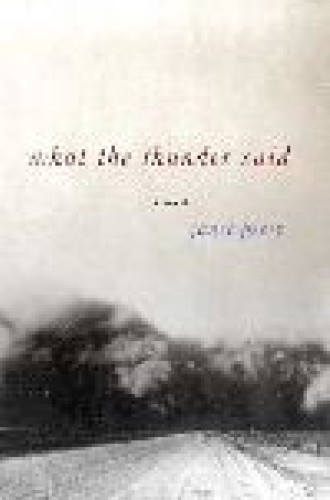What the Thunder Said: A Novella and Stories
Janet Peery’s work is reminiscent of Marilynne Robinson’s: intimate studies rich in character, spare in incident, powerfully rendered in plain speech and deceptively simple sentences. Like Robinson’s, Peery’s published output is small—not for want of talent but because she fiercely attends to elements of craft, like a cabinetmaker fussing over dovetail joinery that few may ever notice.
Peery’s skill doesn’t call attention to itself. Some authors risk losing an edge to their stories when they plane down sentences to ideal smoothness. Peery suffers no such sophomoric lapses. Her problem is simpler: not enough people know and read her. Unlike Robinson, who won the Pulitzer Prize for Gilead, Peery remains in that honorable but unsatisfying bridesmaid’s category: the writer’s writer. Peery’s 1996 novel, The River Beyond the World, was a National Book Award finalist, but she has yet to win a larger readership with a breakthrough work.
I deeply admire Peery’s new work of fiction, but its structure—a novella followed by related stories—may not sit well with literary juries. The novella, accounting for more than half the text in What the Thunder Said, begins with a brief narrative prologue built from dreams, remembered incidents and the everyday details of a life in decline. The life in question is that of 90-year-old McHenry Spoon, whose “unsettled business with the living” jerks his mind from past to present and back again. These few pages reveal matters of identity and relation that frame all that follows.
Then, in a narrative shift that would beg for a dissolve shot in a film, we are back in Dust Bowl Oklahoma. On a small, decaying farm stripped of soil live the Spoons: McHenry, his wife, Billie Ann, and their daughters, Mackie and Etta. The two young women watch, helpless, as their parents sell off livestock and household treasures, and they both dream of leaving. Headstrong Etta, forever outshining her older sister, declares her longing openly and impulsively, while the self-conscious Mackie is more discreet and methodical.
Into this unstable mix of secrets and resentment drifts a 17-year-old Indian boarding school truant by the name of Audubon Jay Kipp, who stays to help with what little farming remains possible. If this were simply a plot-driven work of fiction, the reader might close the book here, confident of what will come of this youthful triangle. Peery, though, is far less concerned with describing events than with rendering character, manner and setting in spare, direct, lyrical prose, as in this short paragraph that follows a matter-of-fact account of a vigilante killing:
Under a cottonwood tree the men set up camp to drink the liquor. Sprawled beneath the tree, they slept all day, woke up at suppertime. I had stewed the pullets, made some dumplings to keep my mind off the idea of Audie and Etta. In the daylight the possibility didn’t seem so near at hand, and so I wrote off my suspicions to the horror of the night before, the closeness of true evil.
Unexpectedly, the plot turns in the middle of the novella when Mackie leaves her father, Audie and a pregnant Etta to go off and “make my own mistakes.” Answering an ad for a housekeeping job in the misnamed Belle Plaine, Kansas (and lying about her age to get the position), she discovers as much secrecy and desire in her employers’ family as in her own, though here she assumes more of Etta’s role in the ongoing domestic tragedy. When Mackie at last leaves Belle Plaine, she is pregnant and emotionally wounded, desperate for some form of resolution, yet unable to face her sister when Etta hazards a reconciliation. Decades later, she reflects on her own tortured relationship with her father’s Christian belief and sighs, “I don’t know anything for sure except that there’s no use for a faith to make me ready for the life to come when what I always stood in need of was a faith to make me better fit for this one.”
A less adventurous author might have called it a day and ended her tale there, but Peery has more. What follows are five short stories and an epilogue, each one further evidence—if any were needed—of Peery’s command of the short-story form. One by one, figures from the novella appear obliquely in stories narrated by a variety of figures, familiar and strange.
The unanticipated fallout from Etta and Mackie’s rivalry crystallizes in telling moments spread over decades. Fortunately, Peery is too accomplished to let these degenerate into heavy-handed plot resolution. In the epilogue, two elderly men testily debate religion and the law, a character from the novella contemplates her end, and a generation-too-late reconciliation may be moments from realization. But that’s it. Except for what might otherwise be a throwaway line, “Just live. Recover and be changed, but live.” Peery leaves it to the reader to pull together loose ends, though she provides the necessary string to do so.
But the question remains: Does the book’s structure work? Purists may conclude that Peery missed her chance to smooth over absent transitions and impose clearer unity on the whole, but I prefer things as they are. The final form, I suspect, grew organically through the writing. Whatever its genealogy, the linear discontinuity between the novella and the stories emphasizes the ways that our current actions, however autonomous they appear, are moved by events of which we know little or nothing. Not that I read Peery as a determinist; her characters are too feisty and her moral sensibility too muscular for that. Nominating committees and national juries will decide whether Peery has crafted a sturdy hybrid or a gangly chimera. In the meantime, I hope readers new to her work will decide for themselves.





